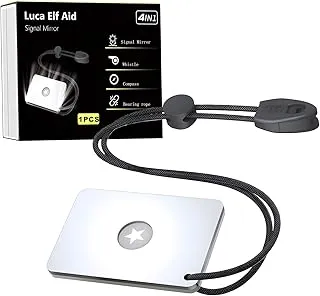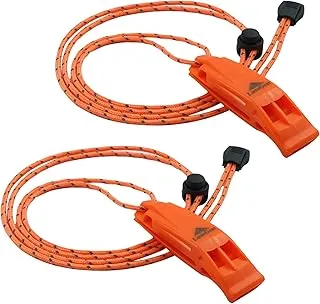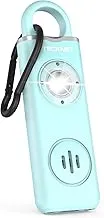When faced with an emergency situation, knowing how to signal for help can mean the difference between life and death. Whether you're lost in the wilderness, experiencing a personal safety threat, or dealing with any crisis situation, effective signaling techniques are essential survival skills that everyone should master. From traditional methods used by outdoor enthusiasts to modern technology solutions, this comprehensive guide covers every aspect of emergency communication you need to know. As someone who has spent years exploring the backcountry and teaching wilderness survival, I've witnessed firsthand how proper signaling knowledge can save lives. Visit Nature Guests for more outdoor safety resources and expert guidance on emergency preparedness.
Understanding Emergency Signaling Fundamentals
Emergency signaling is more than just a survival skill—it’s a lifeline when things go wrong outdoors. At its heart, the practice is about amplifying your presence so rescuers can detect you quickly, even in vast or challenging environments. Effective techniques range from traditional methods like signal fires, whistles, and reflective mirrors to modern electronic devices such as personal locator beacons (PLBs) and satellite messengers. Each method has specific strengths depending on terrain, weather, and available resources, but they all share one critical factor: the ability to catch and hold human attention in moments where every second counts.
The universal principle of emergency signaling follows the "Rule of Three" – three of anything (whistle blasts, mirror flashes, smoke columns) typically indicates distress rather than normal activity. This convention has been established globally because it's easily distinguishable from natural occurrences or routine human activity. During my years as a wilderness guide, I've observed that the most successful rescues occur when victims use multiple signaling methods simultaneously, creating what experts call "signal redundancy."
Effective signaling also depends heavily on timing and environmental awareness. During daylight hours, visual signals like mirrors, bright clothing, or smoke work best. At night, lights, fires, and auditory signals become more effective. Weather conditions significantly impact signal effectiveness – wind can carry sound further but may disperse smoke signals, while clear skies are ideal for mirror flashing but terrible for smoke visibility.

The psychology of rescue operations reveals that searchers typically look for patterns that don't occur naturally. Straight lines, geometric shapes, contrasting colors, and repetitive sounds or flashes all catch human attention more effectively than random or natural-looking arrangements. Professional search and rescue teams are trained to identify these deliberate patterns, making your signaling efforts more likely to succeed when you follow established conventions.
Traditional Survival Signaling Methods
Traditional signaling methods have saved countless lives throughout history and remain highly effective today. These time-tested techniques require minimal equipment and can be implemented using natural materials found in most environments. Learning how to signal for help using traditional methods ensures you're prepared even when modern technology fails.
Fire and Smoke Signals
Fire serves dual purposes in emergency situations – providing warmth and creating visible signals. During daylight hours, smoke is your primary signaling tool, while flames become more visible after dark. To create effective smoke signals, build a base fire first, then add green vegetation, wet materials, or rubber items to generate thick, white smoke that contrasts sharply against the sky.
The key to successful smoke signaling lies in timing and persistence. I always recommend maintaining your signal fire throughout peak search hours (typically 10 AM to 4 PM) when aircraft visibility is optimal. Creating three separate smoke columns in a triangular pattern approximately 100 feet apart sends a clear distress message that's impossible to mistake for a routine campfire.
Ground-to-Air Visual Signals
Creating large, visible patterns on the ground can attract aerial searchers from significant distances. Use contrasting materials like bright clothing, rocks, logs, or even snow to create geometric shapes. The international ground-to-air emergency code includes specific symbols: an "X" means "require medical assistance," a straight line means "proceed in this direction," and three parallel lines mean "safe to land here."
These ground signals should be as large as possible – ideally 12 feet or longer for each element. Position them in open areas clear of tree cover, and maintain them throughout your rescue period. I've seen successful rescues where victims used pine boughs against snow, dark rocks against sand, and even trampled grass patterns to create visible contrasts.
Learn proper whistle signaling techniques for emergency situations
Mirror and Reflective Signaling
Signal mirrors can be seen from distances exceeding 50 miles under optimal conditions, making them one of the most effective daytime signaling tools available. Any reflective surface can work – mirrors, polished metal, smartphone screens, or even water in a container. The technique involves angling the reflective surface to bounce sunlight toward your target, creating bright flashes visible to aircraft and distant observers.
Proper mirror signaling requires practice and patience. Hold the mirror close to your eye and extend your other arm toward your target. Adjust the mirror angle until you see the reflected light on your extended hand, then move your hand away while maintaining the angle. This technique, which I teach in my wilderness courses, ensures accurate targeting and maximizes signal effectiveness. For optimal results, continue flashing in series of three with brief pauses between each series.
Modern Emergency Communication Tools

Modern signaling tools combine traditional principles with advanced materials and design, offering superior performance and reliability. These tools are specifically engineered for emergency situations and often provide multiple signaling methods in compact, lightweight packages. Understanding how to signal for help with modern equipment significantly increases your rescue chances while reducing the physical effort required.
Emergency whistles represent the most fundamental modern signaling tool. Unlike shouting, which quickly exhausts your energy and has limited range, a quality whistle can be heard for miles under optimal conditions and requires minimal effort to operate. The three-blast pattern universally signals distress, and modern pealess whistles work even when wet or frozen.
Recommended Emergency Whistle
The LuxoGear Emergency Whistles are Amazon's Choice for emergency signaling, producing 120+ decibel sounds audible up to 2 miles away. These pealess whistles work in all weather conditions and include reflective lanyards for added visibility.
Advanced signaling mirrors with targeting features represent significant improvements over basic reflective surfaces. Military-grade signal mirrors include aiming holes or targeting grids that help direct reflected light precisely toward rescue aircraft or distant observers. These mirrors are virtually unbreakable and maintain effectiveness even after years of storage in emergency kits.
Modern emergency kits often include combination tools that integrate multiple signaling methods. Multi-function survival whistles might include compasses, thermometers, LED lights, and even fire-starting ferro rods. While these combination tools offer convenience and space savings, I recommend understanding each function thoroughly and practicing with your specific equipment before relying on it in actual emergencies.
The advancement in materials science has also improved traditional signaling methods. Modern emergency blankets use space-age materials that reflect both heat and light, serving dual purposes as insulation and visual signals. These lightweight, compact blankets can be seen from aircraft and create effective ground-to-air signals when properly deployed. For comprehensive wilderness safety information, including detailed equipment recommendations, visit our guide on survival tips if lost.
Electronic Devices and Technology Solutions
Electronic signaling devices have revolutionized emergency communication, offering capabilities that far exceed traditional methods. These devices provide reliable, long-range communication even in challenging conditions, and many include GPS features that help rescuers locate you precisely. Learning how to signal for help using electronic devices requires understanding both their capabilities and limitations.
LED Strobe Lights and Flashlights
High-powered LED strobe lights provide excellent nighttime signaling capabilities, visible from several miles away. Modern emergency flashlights often include strobe modes specifically designed for signaling, flashing in patterns that immediately indicate distress. These devices typically offer multiple modes including steady beam, SOS pattern (three short, three long, three short flashes), and rapid strobe.
The key advantage of LED signaling devices lies in their efficiency and longevity. Quality emergency flashlights can operate for dozens of hours on a single battery charge, and many include solar charging capabilities or hand-crank power generation. I always recommend carrying backup batteries and understanding your device's power management features.

Top-Rated Emergency Flashlight
The LED Flashlight 2 Pack features 5 modes including emergency strobe, waterproof design, and zoomable focus. These tactical flashlights are Amazon's Choice for emergency preparedness with over 14,000 positive reviews.
Satellite Communication Devices
Personal locator beacons (PLBs) and satellite messengers represent the gold standard in emergency communication technology. These devices can send distress signals and GPS coordinates directly to search and rescue authorities regardless of cellular coverage. Many modern units allow two-way communication, enabling you to coordinate with rescuers and provide status updates throughout the rescue process.
Satellite communicators typically require subscription services but offer unparalleled reliability and global coverage. I've personally used these devices during remote expeditions and can attest to their effectiveness. The ability to send your exact coordinates along with a distress message dramatically reduces rescue time and increases survival odds. Some units also include weather forecasts, navigation features, and the ability to share your location with family members.
Smartphone apps have also evolved to include emergency features, though cellular coverage limitations restrict their usefulness in remote areas. Many phones now include emergency SOS features that can automatically contact authorities and share your location when activated. However, I never recommend relying solely on smartphones for emergency communication – battery life, signal availability, and device durability remain significant concerns in wilderness environments. For detailed information about staying safe during outdoor adventures, check our comprehensive guide on staying safe off trail.
Personal Safety and Domestic Situations
Understanding how to signal for help extends beyond wilderness emergencies to include personal safety situations, particularly domestic violence scenarios where discretion is crucial. Recent developments have introduced specific hand signals and covert communication methods designed to help individuals request assistance without alerting potential threats to their actions.

The Signal for Help Hand Gesture
The "Signal for Help" hand gesture was developed by the Canadian Women's Foundation during the COVID-19 pandemic to provide a discrete way for domestic violence victims to request assistance during video calls. The signal involves showing your palm to the camera, tucking your thumb into your palm, then folding your fingers down over your thumb in a trapping motion.
This signal has gained international recognition and has already been credited with saving lives. However, it's crucial to understand that this signal works only when someone who recognizes it is watching and able to respond appropriately. The signal means "reach out to me safely" rather than "call 911 immediately," emphasizing the importance of understanding proper response protocols.
Personal Safety Alarms
Personal safety alarms provide audible alerts that can deter attackers and attract help in threatening situations. Modern personal alarms produce sounds exceeding 120 decibels – loud enough to be heard several blocks away and uncomfortable enough to disorient potential threats. Many include LED strobe lights and GPS tracking features that automatically alert emergency contacts.
Recommended Personal Safety Alarm
The TECKNET Rechargeable Personal Safety Alarm delivers 130dB sound with SOS strobe light, low battery notice, and USB charging. This highly-rated device is Amazon's Choice for personal protection with over 555 positive reviews.
Coded Communication Methods
Several coded communication methods have emerged to help individuals request help discretely. The "Angel Shot" system used in bars and restaurants allows patrons to order specific drinks that signal staff to assist with potentially dangerous situations. Text-based codes like "pizza delivery" calls to 911 have also been documented, though these require dispatcher awareness of the coding system.
Digital safety tools continue evolving, with smartphone apps that can send automatic alerts to emergency contacts when activated discretely. Some apps use code words or require specific gesture patterns to prevent accidental activation while ensuring rapid response when genuine emergencies occur. The key principle remains creating signals that potential helpers can recognize while remaining invisible to threats. Understanding these methods is part of comprehensive emergency preparedness, alongside knowing basic first aid – learn more in our guide to hiking first aid kit essentials.
Building Your Emergency Signaling Kit
Creating an effective emergency signaling kit requires balancing functionality, weight, and reliability while considering your specific activities and risk factors. A well-designed kit should include multiple signaling methods to ensure redundancy – if one method fails or proves ineffective in specific conditions, you have alternatives available. Understanding how to signal for help includes knowing how to select, maintain, and deploy these tools effectively.
Essential Signaling Tools
Every emergency signaling kit should include a quality whistle, signal mirror, LED flashlight with strobe mode, and emergency blanket or bright marker panel. These four items provide visual and auditory signaling capabilities for both day and night conditions while remaining lightweight and compact enough for any activity level.
The whistle serves as your primary auditory signal – choose pealess designs that work when wet and produce sounds exceeding 100 decibels. Your signal mirror should be military-grade with aiming features, typically measuring at least 2x3 inches for effective range. The flashlight must include multiple modes including SOS pattern, and LED technology ensures long battery life and durability.
Emergency blankets serve multiple purposes beyond signaling – they provide insulation, wind protection, and highly visible reflective surfaces that can be seen from aircraft. Choose versions that include grommets or tie-points for secure deployment, and practice setting them up as ground signals before you need them in actual emergencies.
.webp)
Complete Emergency Signal Mirror
The Military Grade Signal Mirror 3-in-1 includes compass and whistle in addition to professional signal mirror capabilities. This compact device is Amazon's Choice for outdoor adventure emergency equipment with over 700 positive reviews.
Advanced Kit Considerations
Advanced emergency kits might include satellite communicators, personal locator beacons, or two-way radios for areas with repeater coverage. These electronic devices significantly improve your rescue odds but require batteries, subscriptions, or licensing depending on the specific technology. I recommend understanding the operational requirements and limitations of any electronic device before depending on it for emergency use.
Consider your specific activity risks when assembling your kit. Hiking in dense forest requires different signaling strategies than desert backpacking or winter mountaineering. Forest environments may limit long-distance visual signals but enhance sound transmission, while open terrain favors visual signaling but may disperse sound quickly. Seasonal changes also affect signaling effectiveness – snow improves contrast for ground signals but can muffle sound, while summer vegetation might hide visual signals but won't impede electronic devices.
Regular maintenance ensures your signaling equipment functions when needed. Check batteries quarterly, inspect mirrors for cracks or scratches, and verify whistle operation. Practice using each device in your kit – muscle memory developed during calm conditions becomes invaluable during high-stress emergencies. Store your kit in an easily accessible location and ensure all family members or group participants know its location and basic operation procedures.
Documentation becomes crucial for electronic devices – maintain instruction cards with basic operating procedures, emergency contact numbers, and any subscription or registration information. Waterproof storage protects both equipment and documentation, and I recommend double-bagging critical items in ziplock bags even within waterproof containers. Your signaling kit represents your lifeline during emergencies, so invest in quality components and maintain them properly. For additional safety considerations specific to trail injuries, our guide on treating blisters on trail provides essential first aid knowledge.
Conclusion
Mastering how to signal for help requires understanding multiple techniques, practicing with your equipment, and maintaining situational awareness during emergencies. From traditional methods like fire and mirror signals to modern electronic devices and personal safety protocols, effective emergency signaling combines time-tested principles with advancing technology to maximize your chances of successful rescue.
The key principles remain consistent regardless of your chosen methods: visibility, persistence, and redundancy. Make yourself as noticeable as possible through contrasting colors, geometric patterns, and repetitive signals. Maintain your signaling efforts consistently rather than sporadic attempts. Include multiple signaling methods in your emergency preparedness to ensure alternatives when primary methods fail or prove inappropriate for specific conditions.
Remember that signaling is just one component of comprehensive emergency preparedness. Proper planning, quality equipment, emergency communication plans, and basic survival skills all contribute to successful outcomes during crisis situations. Practice these techniques regularly, maintain your equipment properly, and stay informed about new developments in emergency communication technology.
Whether you're planning a wilderness adventure, concerned about personal safety, or simply want to improve your emergency preparedness, understanding these signaling techniques could prove invaluable. Take time to assemble appropriate signaling equipment for your needs, practice using it effectively, and ensure family members or frequent companions understand basic emergency communication principles.
Emergency situations test our preparation, knowledge, and composure under pressure. By understanding multiple approaches to emergency signaling and maintaining quality equipment, you're significantly improving your ability to communicate distress and coordinate rescue efforts when they matter most. Stay safe, stay prepared, and remember that proper signaling techniques save lives. For more comprehensive outdoor safety resources and expert guidance on emergency preparedness, visit our complete collection of survival guides at Nature Guests.
Ready to Build Your Emergency Kit?
Don't wait for an emergency to wish you were better prepared. Start building your emergency signaling kit today with these highly-rated, proven tools.
Shop Emergency Signaling Equipment

